Building A Relationship With Your Neck Muscles
Karl Pojello, the great wrestler, once said: „Chain no stronger than weak link.“ He knew about the importance of strong neck muscles. And especially he knew about the importance of functional strength. His quote goes on with the words: „Mat game only sport which builds strong neck.“
About Functional Strength
If you want your body strong, endurant, flexible or with one word- well conditioned, you have to use it this way. Barbells, Dumbbells and other apparatus can build strength only in a linear way, up and down, front and back. By using the treadmill or stairmaster you got a similar workout for endurance. And from workout to workout your routine will become more and more dull.
After my opinion having functional strength means, being able to react, to contract or relax the muscles when it‘s time for it. So you need strong joints, flexible muscles and soft tissue. And everything has to be connected to an open mind and a fast brain. Have you ever been to a situation where you realized „great I’m doing biceps curls once a week“? Will you ever come to such a situation?
But what is with running after a bus, avoiding a car crash, catching a falling glass? Daily situations that could be solved by intelligent or functional training.
About Functional Neck Strength
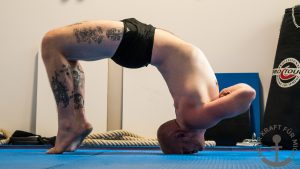
Most people ain’t wrestlers or pugilists so they don’t need a strong neck for fighting. But how often do they got a stiff neck after turning their head too fast to catch a glimpse of the beauty passing by or hitting their car breaks unexpectedly- hopefully not for the same reason… Nowadays it becomes more and more popluar having neck strains after long sessions in front of a desktop. The upper back of so many people is getting formed like a question mark.
To make it simple functional neck strength is characterized by being able to adapt to positions, abrupt changes of direction or resisting pressure.
Conditions for Neck Conditioning
The most important condition is the fragile structure of the cervical spine. It’s constructed for being moved in many directions and ankles, so its flexibility can cause much problems when not moved with caution. And it is not made for holding or moving heavy loads. Its adaption to stand heavy resistance takes some time. Especially wrestlers use the Wrestler’s Bridge or the Headstand in order to strengthen their necks, but by doing this the intervertebral discs between the cervical vertebra are squeezed heavily and this movement can provoke a slipped disc. Both can be great

exercises if done properly but you have to keep control over the neck muscles and the jaw muscle m. masseter.
Next condition is the muscles itselves. There are many very small muscles that simply can’t be worked. And even if it was possible, it wouldn’t have much use, because they’re simply too small for generating strength. So you have to concentrate on the m. sternocleidomastoideus and the m. trapezius. In their function of holding or moving their head they developed themselves in muscles with great endurance, so they have to be worked with many repetitions or, when doing isometric exercises, over long periods of time.
Having sore neck muscles ain’t a plaesure and sometimes goes along with headaches so it’s wise to work them constantly but never too heavy. Every day a little bit of training will result in a steady adaption and most important- you will become able to feel the muscles. You will built up neuromuscular coordination.
Many strength trainees make an unnecessary mistake- they train too much. The muscles are able to adapt within a few training sessions, so the people feel like becoming stronger and they increase the resistance. And then they injure themselves because the sinews and tendons need up to three months for their adaption. So start slowly and move on constantly.
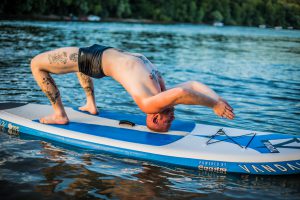
The most interesting Muscles of the Neck
Before thinking about exercises you have to figure out what should be exercised. As said before the neck has many small muscles, you can’t build up. So you have to focus on m. sternocleidomastoideus, and m. trapezius. The first one, easily called sternocleido, has many functions- holding, turning, bending, lowering, raising. Its name means that it connects the head (the part behind the ears) with the sternum and clacvicula. The m. trapezius has its name because of its form, but it is not important as a whole. To strenghten the neck you need only the upper part of it- the pars descendens, it lifts the shoulders, pulls them back and moves the head back.
Training the Neck Muscles
1. Building neuromuscular coordination
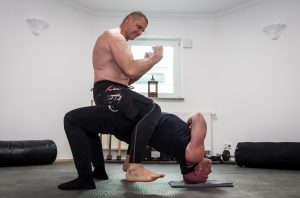
Normally we are not conscious about our muscles, if we want to make a movement we do it if we are able to- or we fail. But failure is not a must. If we build up the connection from brain to muscle and muscle to brain we become able to contract or relax a muscle when we want to. Building up this connection is just a learning process. It works by repeating a movement, but this has to be done without strain. When it’s easy you are able to feel the movement. You are able to feel the blood flowing into the muscles and after a while you feel a burn. After some sessions the muscles will grow a little and feeling them becomes easier and through conscoius training you will become able to contract or relax them without the movement, just by your will. Then you got the possibility to work them to a higher degree.
2. Protect your cervical spine
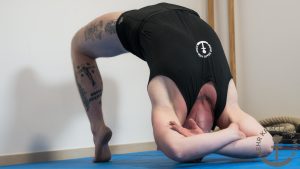
When training the sternocleido it’s easy to provoke a slipped disc between cervical vertebrae. But this can only occur if you bow your head. Many people practicing Neck Nods/ Neck Crunches bow their head to their chest like they aim to squeeze their discs out of the back of the neck. That is dangerous and in order to strengthen the sternocleido only half-useful. When training your sternocleido keep your neck straight and move the bottom of your chin to your sternum. And keep your neck straight!
Working the trapezius requires exactly the opposite- bend your head back. This keeps the discs inside and the movement itself contracts the muscle. If you keep your neck straight the complete movement is done by your cervical spine and not by any muscle. So when doing the Wrestler’s Bridge, for example, always look behind you!
3. Use intelligent exercises
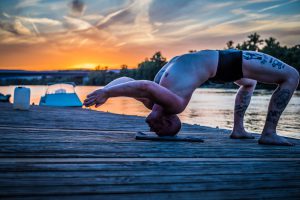
Intelligent exercises are characterized by training the body in the desired way, while preventing injuries.
At first you have to learn conscious moving of the head. Practice all motions only in this way that no discomforts occur! If you feel a sticking point don’t try to overcome it! If you feel well while moving your head increase the range of motion steadily.
Warm-up
Start with bowing the head carefully to your chest and raising it slowly. Then turn your head from side to side. Go on with bending your head to the sides in order to touch your shoulder with your ear. Practice every motion for twenty repetitions.
Exercises
The first exercise aims to develop the sternocleido. Sometimes it’s called Neck Nods, sometimes Neck Crunches. Lie flat on your back, the hands on the stomach. Put the feet on the floor, so that your legs are bent. While keeping your cervical spine straight raise your head. Your goal is to touch your sternum with the bottom of your chin. If you can’t reach it, don’t worry, increase the range of motion from time to time. With your hands resting on your belly, you make sure that your abs are relaxed. The whole movement is done by your sternocleido. And your cervical spine is kept straight!
If you’ve practiced Neck Crunches for a while and feel comfortable about it, you can increase the resistence on your sternocleido by lying down on a bench or bed or couch. Then you have to place your thoracic spine at the edge and your head hanging in the air. Now you can increase the range of motion by bending your head back. This motion requires a high degree of concentration because you have to contract your sternocleido in order to keep your cervical spine straight while your abs stay relaxed and soft.
The next exercise is Head Lifts. After doing your Neck Crunches turn around on your belly with your nose touching the ground. Pull your shoulders back, keep them behind and your scapulae at your spine. Now roll back your head as high as you can without any discomfort. This motion is very easy and you will be able to make it more difficult pretty soon. To do this place your sternum on the edge of a bench, bed, couch while the clavicula still touch it but your neck and head are in the air. Now you combine the rolling back of the head with reverse Neck Crunches.
Go on with Head Twists for strenghtening your sternocleido. Turn around again to your back, place your hands on your belly and lift your chin to your clavicula. To do this you have to turn and bend your head a little, but keep your cervical spine straight again. If you want to make it harder, just place your thoracic spine at the egde of a bench, bed, couch and bow your head backwards, when raising it up, start the twisting to one of your claviculums. Bow back again and repeat the movement to the other claviculum.
Practice this routine one or two times per day and increase to twenty repetitions at each exercise. When you are able to do this go on like this for four weeks, then increase the repetitions to thirty, do this for a week, increase to fourty, do this for a week and increase to fifty and keep this routine for a couple of months. You will know when to go on and increase again! Just take some time for adaption to the resistence. If you do it constantly and controlled and do hundreds of repetitions you don’t need any additional weights or apparatus and your cervical spine will be happy and healthy all the time!
If you want more- here’s some more exercises! At first a very simple but well-working one. I named it in honor to Martin ‚Farmer‘ Burns the Burns Bridge. Kneel down and place your forehead on the
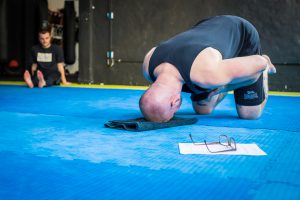
floor, best on a mat or a towel, your feets are hanging in the air. The distance between knees and forehead doesn’t need to be long. You will create the resistence by pressing the forehead down, that way it’s a controlled motion. At the beginning your nose touches the floor, too. Then you pull your body with your forehead in order to touch the ground with your upper head, while exhaling and contracting the sternocleido. Your knees stay fixed on the floor like some kind of seesaw. After pulling with your head push your body back to touch the floor with your nose again and inhale. Doing this your cervical spine is kept straight! Contract your sternocleido as much as you can and practice consciously.
After it do the Wrestler’s Bridge Neck Specialization. Lying on your back, put feet on the floor parallel, close to your bottom. Roll your head back, so you can look behind yourself. Pull your shoulders back. Contract your glutaeus maximus and press your body from the ground. Only the back of your head and the feet are touching the floor. But don’t press too high! Stay low, so your back is lifted just a little. Lower down to the ground and press up again. The range of motion is only three inch. Performing the Wrestler’s Bridge this way you use your muscles while your cervical spine is safe.
When it is too easy for you try the Headstand Bridge! Holding a headstand standing on your
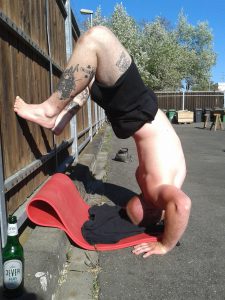
forehead with feet on a wall and a backbending roll your nose to the floor and by contracting the sternocleido push yourself back on your forehead. Keep your hands in line with your forehead, so you can increase or decrease the pressure on your neck. Additionally you work the middle part of your traps as well. And because of the reverse position the blood flows directly to the muscles needing it. This increases hypertrophy. But: perform the headstand only on the forehead- then you can hold your bodyweight with the sternocleido and not with your cervical spine squeezing the discs and provoking slipping of them.
In order to increase strength and neck girth, practice the same routine as above- work up to twenty repetitions and so on…
Very popular, but most of the time performed pretty badly- the Wrestlers’s Bridge Isometric. The starting point is the same as above. Feet parallel, hips-wide, shoulders pulled back. Lift your body a bit and then, by assisting with your hands squeeze your body, to put head and feet closer together. Place your upper head on a mat or a towel. Now the work begins! Push your feet in the ground as hard as you can. Hold your knees together. Contract your glutaeus maximus as hard as you can. Pull your shoulders back. Hold your hands and ellbows together. And now the masterpiece: keep your jaw closed, while contracting the sternocleido like pulling it to your chest but keep your head fixed on the ground. All joints are fixed now and your body is working as a unit to hold the position. So you can build up allround power with just one exercise. Hold it for some time and increase the time you are able to hold it.
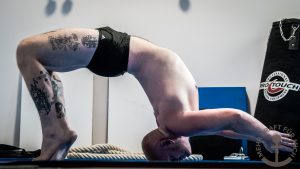
That’s it! A small guide to functional neck strength. Start slowly and move on constantly.
“I wish to impress upon all my students the great value of physical training connected with the bridge exercise. I want you to practice bridging every day, for you can find nothing that will develop the neck and back muscles to such an extent as bridging will do.
You already realize the importance of a very strong neck and it is entirely up to you to have a wonderful neck or not, depending entirely on the amount of study, and time of practice that you give the subject. A strong, well-developed neck is not only valuable to health and your personal athletic appearance, but important in wrestling as well.” (Martin ‘Farmer’ Burns, 1912)
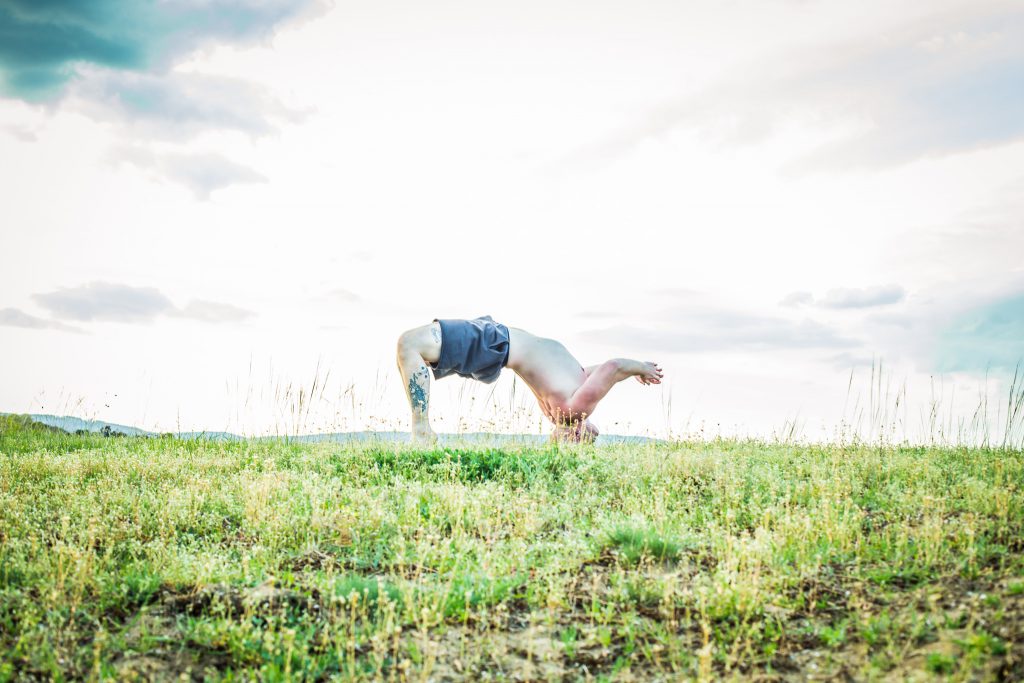
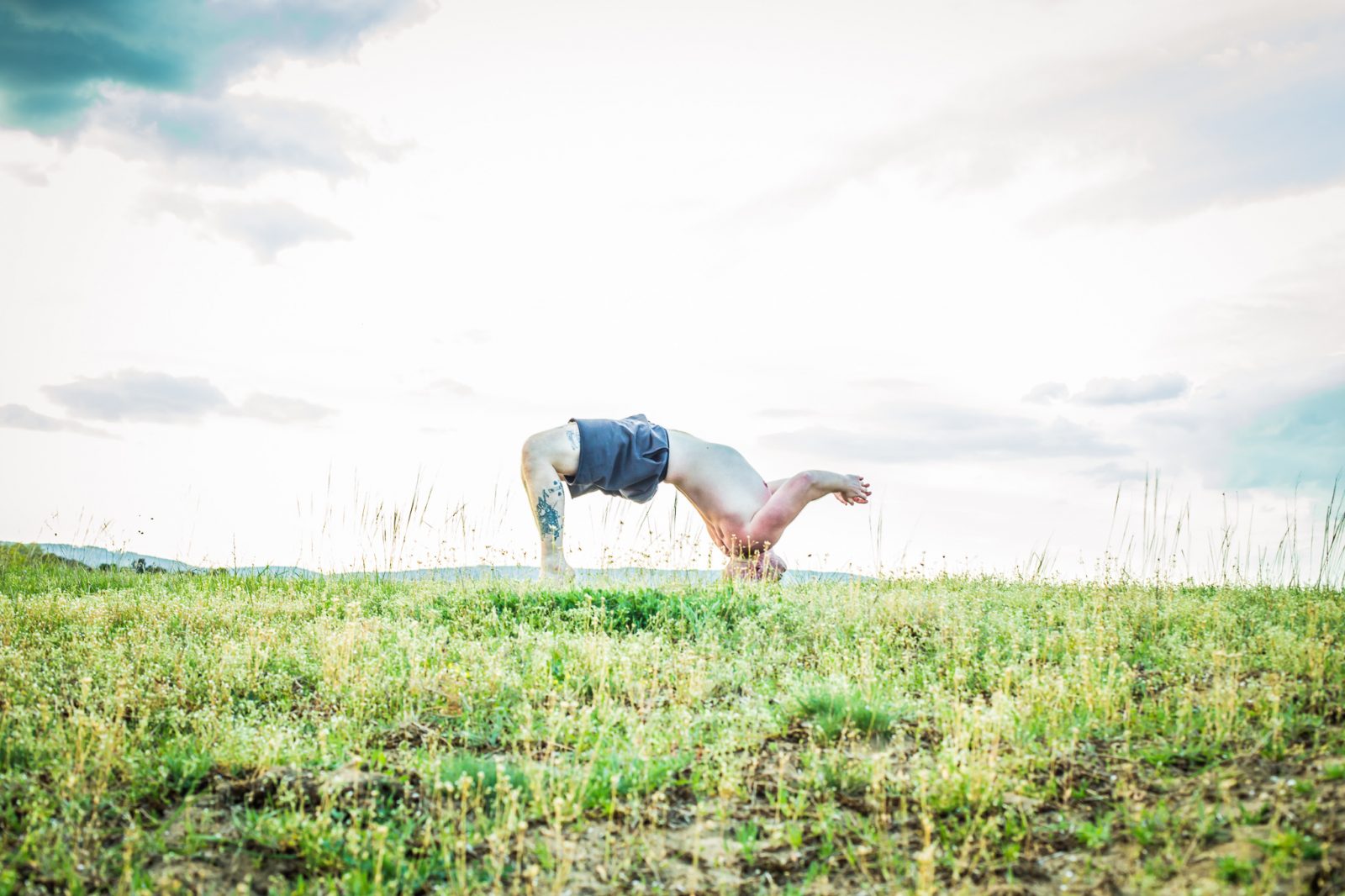

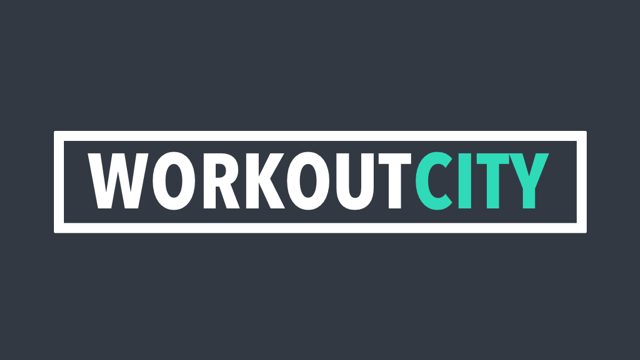
Very well described exercises for neck muscles. And looking forward for more informative and helpful posts. Thanks.
Thank you for your kind words. I’m looking forward for writing more posts! 🙂
Pingback: My Way with Vyayam – Jan Markus Adams